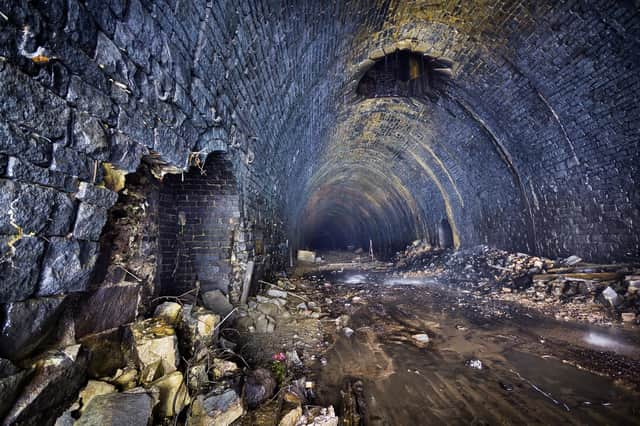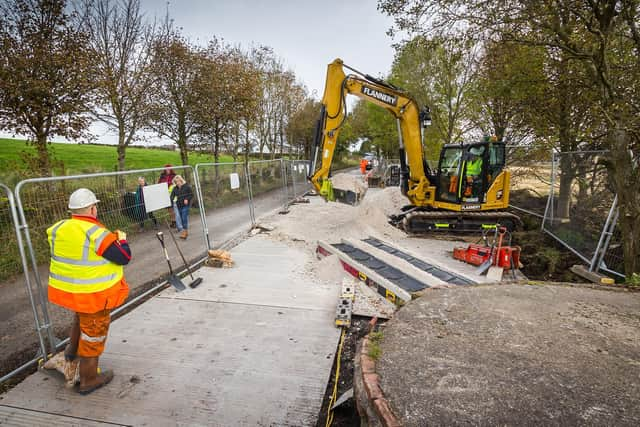Queensbury Tunnel campaigners urge enforcement action over tunnel infilling


Queensbury Tunnel is the centrepiece of a proposal to develop an active travel network connecting Halifax to Bradford and Keighley, with the Department for Transport committing £1 million to technical and feasibility studies. However its custodian, National Highways, has longstanding plans to abandon the 1.4-mile long engineering feat and infilled a short section of it in October 2019 following an inundation of groundwater.
The Victorian structure has been affected by flooding since the 1970s but, campaigners say, in March 2015, an agreement to lease land at its southern end allowed the state-owned roads company to commission a pumping station. But, campaigners say, it never paid the £50 annual rent and the equipment was turned off by the landowner in September 2018, shortly before contractor AmcoGiffen was due to begin a 12-week programme of enabling works for the abandonment scheme, costed at £550K.
Advertisement
Hide AdAdvertisement
Hide AdThe tunnel flooded and the project had to be replanned. The contractor eventually left site in October 2021, campaigners say, with the taxpayer facing a bill of more than £7.2m and the enabling works still incomplete.


In late September 2019, six days of persistent, torrential rain overwhelmed AmcoGiffen’s temporary pumps, campaigners say, causing its workforce to retreat from the tunnel. With concerns over a bulge in the lining’s sidewall, National Highways used emergency development powers - known as Class Q - to tip hundreds of tonnes of stone down a nearby ventilation shaft (No.2 Shaft), campaigners say, filling both it and the tunnel. But the powers only facilitate temporary works and the material should have been removed within six months. According to campaigners, the infill is now unlawful.
The Queensbury Tunnel Society has urged Bradford Council’s planning team to take enforcement action against National Highways, asserting that “It undermines public confidence in democratic process when statutory bodies are allowed to flout their obligations without sanction whilst the less powerful feel the full weight of regulatory process bear down on them. The law must be seen to apply equally to everyone.”
In June, Eden District Council rejected National Highways’ planning application to retain 1,600 tonnes of stone and concrete in which Cumbria’s Great Musgrave bridge was buried last year, again involving Class Q powers, campaigners say. The structure was needed for a connection between two heritage railways.
Advertisement
Hide AdAdvertisement
Hide AdNorah McWilliam, leader of the Queensbury Tunnel Society, said: “It’s time to draw a line under National Highways’ continued abuse of development powers. The company believes it can do whatever it likes, whenever it likes and won’t be challenged. Eden District Council proved them wrong last month and Bradford Council must do the same over Queensbury Tunnel.
“Officers tried to stop the shaft’s infilling whilst it was ongoing, but failed to act with sufficient urgency. The misuse of Class Q powers - which have long-since expired - provides the opportunity to put this matter right, bringing the prospect of a strategically-valuable cycle route that bit closer.
“Bradford is planning hundreds of great cultural events as part of its City of Culture status in 2025, but none would match the solid built-in legacy that restoration of the tunnel would bring to communities and the local landscape. It needs to be driven forward.”
But last year National Highways blocked the tunnel at a second location when it spent an estimated £2.8m, campaigners say, assembling a basket-and-grout plug below another ventilation shaft (No.3 Shaft). In the last three months of 2020, AmcoGiffen charged £264k for security alone, say the campaigners.
Advertisement
Hide AdAdvertisement
Hide Ad“Queensbury Tunnel became a money pit for the taxpayer”, said Graeme Bickerdike, the Society’s engineering coordinator. “National Highways’ failure to pay the £50 annual rent pushed the costs up by around £6.7m - an extraordinary act of incompetence for which nobody has been held accountable.
“The shaft plug was the most complex, costly and high-risk project ever undertaken by the company’s Historical Railways Estate team. And yet there are no engineering drawings, no progress reports, no safety plans and no email traffic. They adopted a scorched-earth policy to record-keeping to ensure nobody knew what was going on.
“The company is not subject to sufficient scrutiny and acts accordingly. It must be reformed.”
National Highways submitted a planning application for Queensbury Tunnel’s abandonment in 2019 and more than 7,800 people have so far lodged objections.
Advertisement
Hide AdAdvertisement
Hide AdNational Highways’ Head of The Historical Railways’ Estate programme, Helene Rossiter, said: “The decision on Great Musgrave has no connection to, or impact on, Queensbury Tunnel.
“The work inside the tunnel didn’t require planning permission, as agreed by Bradford Council’s planning team. The work took place inside the structure and didn’t change the visual aspect of the tunnel.
“In terms of the current state of play, the repurposing of Queensbury Tunnel for future use for active travel sits with Bradford Council, West Yorkshire Combined Authority and the Department for Transport.
“Our role is to manage the structure and keep it safe while such plans are developed. We have also worked with West Yorkshire Police to prevent unlawful trespassing within the tunnel, which poses a significant safety risk.”